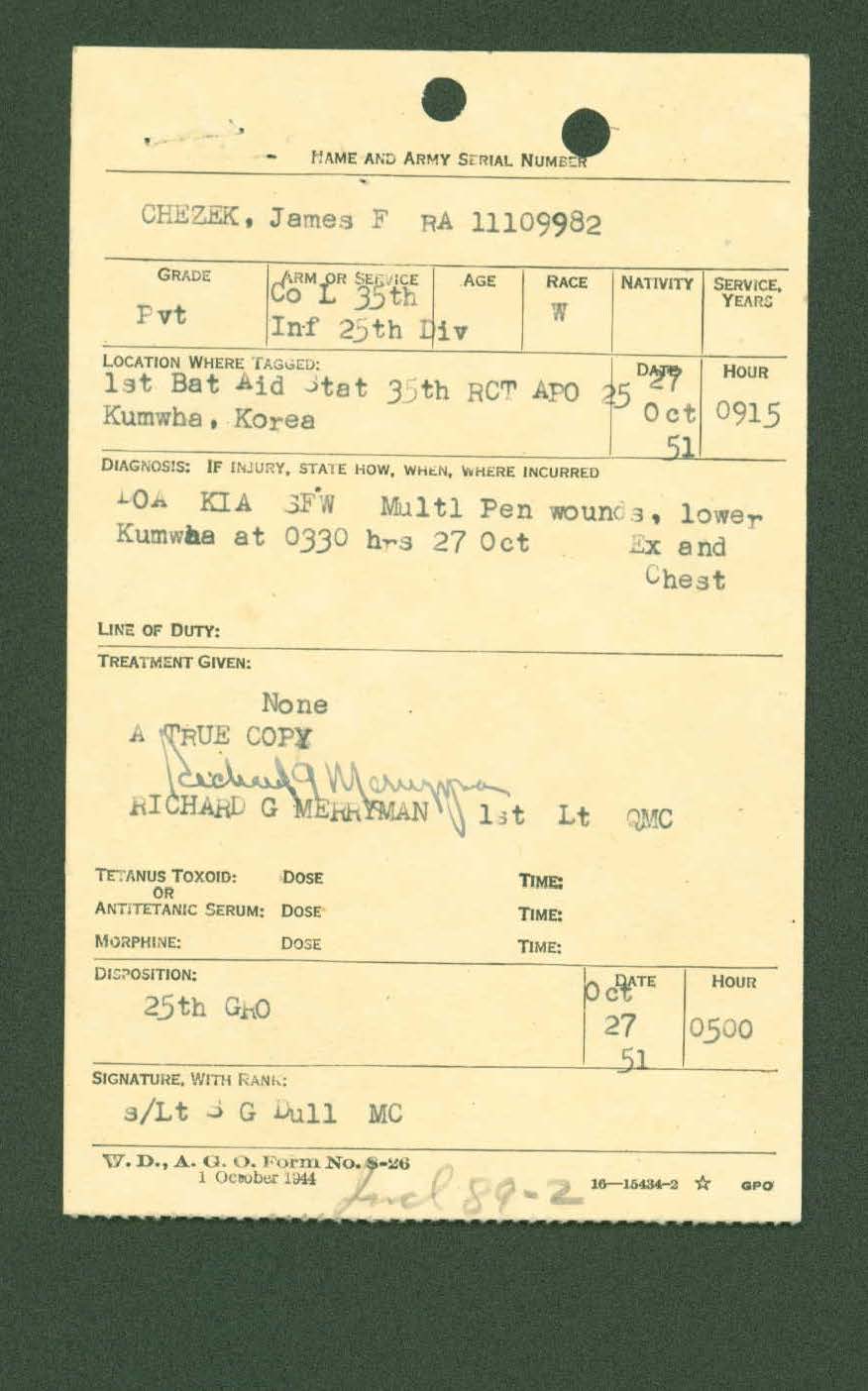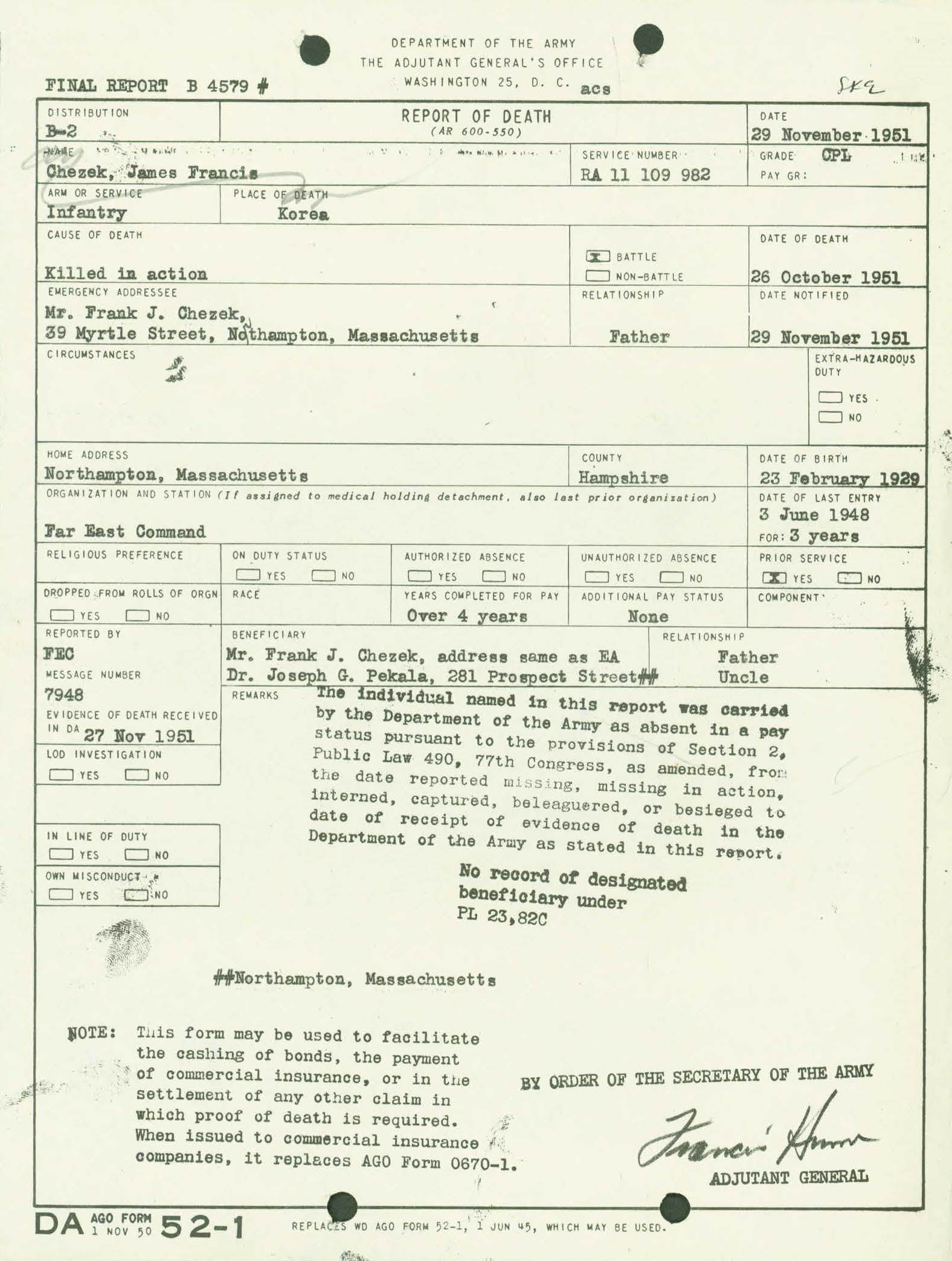Korean War Veteran Search - Home » Military » IDPF in the Korean War: How to Access Korean War Casualty Records from the National Archives
To request a Korean War Casualty File, visit Golden Arrow's order page here: Submit a Korean War Casualty File Request
Korean War Veteran Search

Korean War ID.D.P.F. The casualty file is a vital research tool for individual Korean War veterans who were killed in action or died in the line of duty during the Korean War. In this post, we will discuss why the Korean War I.D.P.F. The casualty record is important to researching the Korean War, what records you can expect to find in your veteran's casualty history, and how to access your veteran's identifying information. record of wounded.
Korean War Memorial In Fullerton Got Donations From Near And Far
Korean War ID.D.P.F. casualty records held at the National Archives contain original documents detailing the deaths and burials of Korean War veterans who died during the Korean War. Korean War ID.D.P.F. The loss records are particularly important because nearly 90 percent of all Korean War military service records were lost in the 1973 archive fire. Korean War ID.D.P.F. casualty records can actually help us reconstruct the death and burial circumstances of an individual KIA veteran, even if the service records were lost in the 1973 archive fire. Korean War ID.D.P.F. casualty records can be used in conjunction with many other sets of alternate records held in the archives to ensure the preservation of the story of an individual Korean War casualty. In this post we are going to explore the Korean War ID.D.P.F. a more detailed list of wounded so you can better understand what to expect when you apply for a Korean War Veteran ID. record of wounded. As you become more familiar with the Korean War, the ID.D.P.F. casualty records I think you'll agree that this is a must for researching veterans who died in war.
Why the Korean War ID.D.P.F. the story of the wounded is so important. Korean War ID.D.P.F. Casualty data can help researchers better understand what exactly happened to a Korean War veteran who died in action. There are many Korean War records in the I.D.P.F. casualty records detail how the Korean War veteran was killed, the placement and burial of the veteran's remains, and the unit to which the Korean War veteran was assigned during combat. In many cases the Korean War ID.D.P.F. the wounded records also contain correspondence to and from the family of the deceased veteran after the Korean veteran became wounded. Letters from family members of a deceased veteran can provide insight into not only what happened to the veteran, but also stories about how the death affected the veteran's family as a whole. In addition to the correspondence common during the Korean War, the I.D.P.F. There are many other records in a victim's file (such as beneficiary documents) that can provide a wealth of information for genealogical researchers trying to learn more about their family history. Let's take a closer look at some of the types of original documents found in the Korean War ID.D.P.F. record of wounded. At the end of this post, I will also provide some suggestions on how you can access the Korean War Veteran IDPF. Crash file.
Korean War ID.D.P.F. casualty report - notification of death. A death report will provide a basic overview of when and where a veteran died in combat. This example gives us information not only about the veteran's date or death, service line and rank, but also about the deceased veteran's next of kin.
Korean War ID.D.P.F. cause of death reports. Korean War ID.D.P.F. casualty records also contain records detailing the cause of death investigation. In this case, the remains of a veteran were recovered from a destroyed bunker in Korea, and the discovery and identification of his remains were documented and placed inside the Korean War ID.D.P.F. record of wounded.
Republic Of Korea War Service Medal
Korean War ID.D.P.F. victims record eyewitness accounts. In some cases, there are eyewitness accounts published during the Korean War by the IDPF. a casualty record to help document how the veteran was killed and/or the process of identifying and recovering the remains of a deceased Korean War veteran.
Korean War ID.D.P.F. reports on the internment of victims. The Import Report is another important document found in the IDP.D.P.F. record of wounded. The opening report shows how the Korean War veteran was killed in action, the unit he was assigned to, and details the personal effects found on the veteran when the body was found.
In some cases where the identity of a Korean War veteran was in doubt, it was necessary to check fingerprints and dental records to ensure that the remains of the deceased Korean War veteran were properly identified.

Korean War ID.D.P.F. medical documents for registration of victims. If your Korean War Veteran was treated or examined at a medical facility during the war, additional medical reports may be placed with the I.D.P.F. record of wounded. In this particular case, the veteran was evacuated to a medical center but was pronounced dead on arrival. The medical diagnosis indicates that the veteran died as a result of shrapnel wounds.
Honor Flight Seeks Wwii, Korean War Veterans
Korean War ID.D.P.F. documents on the personal belongings of the victims. Documents listing the personal effects found on a Korean War veteran when he was killed can provide a unique glimpse into the past. These records can show us, for example, what the veteran was reading, writing, or collecting as memorabilia when they were gone.
Correspondence. Korean War ID.D.P.F. The death log may also include correspondence to and from the veteran's family, as well as letters regarding the release of the veteran's remains from government agencies or funeral homes. These records can be incredibly helpful in researching your own family history. Even letters from non-family members can sometimes provide clues about what was going on within the family itself.
Correspondence deployed as part of the Korean War ID.D.P.F. may also include documentation for the repatriation of the veteran's remains to the United States, among other burial documents.
Although this record contains several different types of records found in the Korean War ID.D.P.F. Wounded Registry I simply have too many different types of reports to cover all the types of documents you might find in your Wounded Veterans file. Your veteran's experience will be unique to him and that means the only way to know is your Korean War Veteran's ID. A casualty file must be ordered from your Korean War Veteran's IDPF. Record of victims from the National Archives.
Korean War Veteran Ian J. Harman (front) From Britain Takes Part In The Annual Gloster Valley Memorial Service At Solma Ri In Paju Near The Demilitarized Zone (dmz), About 50 Km (30 Miles)
How to get a Korean War ID card. Record of victims from the National Archives. Korean War ID.D.P.F. Records of the wounded are kept in the National Archives. Your Veteran ID is the fastest and most convenient way to sign in. is the use of a well-known and reputable research firm. If you contact a reputable research company (such as Golden Arrow Military Research), it will ensure that you receive high-quality digital scans, such as the ones we have presented in this article, in just a few days. A reputable research agency will have research specialists at the National Archives where they scan Korean War ID numbers page by page so you can see your veteran's ID documents and artifacts. just as they appear in their original form. If you are interested in Korean War ID.D.P.F. You can submit a request for information about the wounded in the National Archives in Veterans Identification. here: Claim ID.D.P.F. Record of victims from the National Archives.
Jeff Gentilini is Chief Scientist at Golden Arrow Research. He specializes in military service research for all branches of the US military. For help with obtaining a military service record, you can fill out a request form here: Research a Military Service RecordLAREDO, TX. (KGNS) - It's often called the "forgotten war," but for those who lived through it, that's far from the case.
Wednesday marks the 69th anniversary of the end of the Korean War, but to many it seems like only yesterday.

Laredo veteran Ernesto Sanchez can't help but get choked up when he remembers his time serving in the Korean War.
Laredo Korean War Vet Continues Search For Fallen Brothers
Sanchez says, “We called in our artillery to stop the communists and some of the artillery fell on our men. And it really breaks your heart to see one of your friends killed by friendly fire.”
This year marks the 69th anniversary of the end of the Korean War, and decades later, Sanchez continues the search for the six Laredo men who never returned home.
"We have never left anyone behind in Korea. If one of us died in a minefield, we would clear the minefields and bring him back," Sanchez said.
Ernesto says that even after the war, he never thought about himself. instead, he always thinks of the families of his fallen battle brothers.
Korean War Veterans Honored With New Memorial In Fullerton
Because he realizes that his most important achievement was during the war
Korean war army veteran list, korean war veteran association, world war 2 veteran search, korean war veteran benefits, korean war veteran hat, korean war veteran t shirts, korean war veteran list, korean war veteran cap, korean war veteran flag, korean war veteran records, korean war veteran widow benefits, vietnam war veteran search
0 Comments